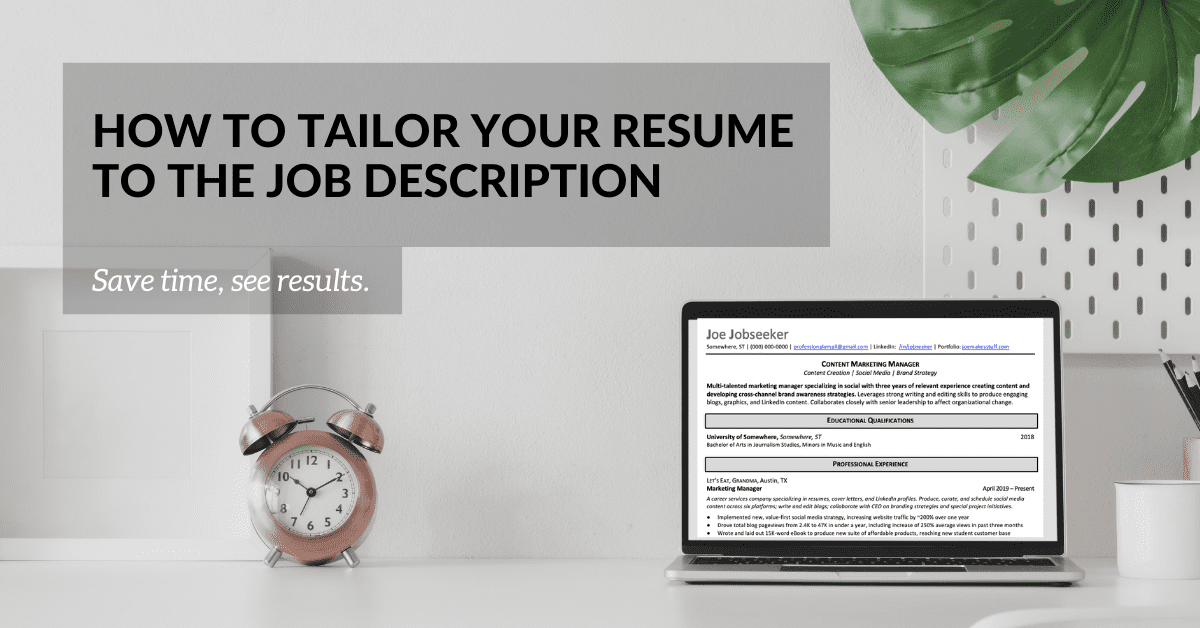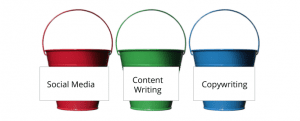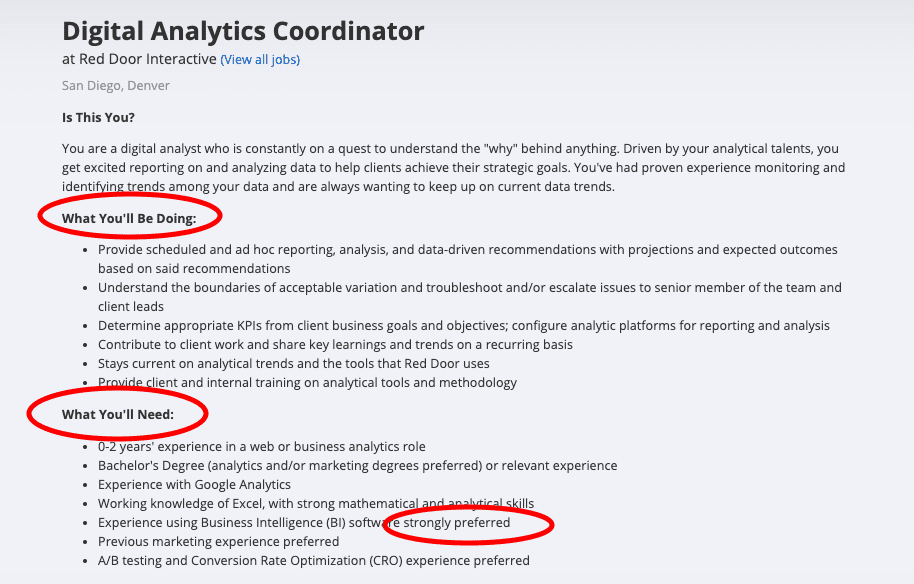Quality > Quantity: How to Tailor Your Resume to the Job (and Land It)

Quality beats quantity when job searching. Learn how to tailor your resume to each job description, and you’ll land more interviews than if you apply for hundreds of jobs with the same resume.
By: Daniel Lorenzo | Marketing Manager for Let’s Eat, Grandma
Did you just apply to your hundredth job, saying a prayer that maybe this one will finally give you an interview?
Take a break for a second. We need to talk about something.
Listen, I know you want, no, need a job as soon as possible. You’ve probably heard people say things like “finding a new job is a full-time job.”
And you’re probably exhausted.
Ready for more job search help?
Sign up for a free Senior Writer Resume Critique to see what's holding you back from landing interviews. One of our top professional resume writers will give you personalized feedback on the top 3 items you can improve based on our expert practices!
But here’s the thing — you need to work smarter, not harder on your job search. If you’re in a position where you’ve applied to tons of jobs only to hear crickets in response, something needs to change about your approach.
If you’re not getting any interviews for jobs you’re qualified for, the problem is likely with your resume. And the solution is making your resume targeted and tailored toward each job you apply to.
Do I really need to tailor my resume to this specific job description?
Yes. For every job. No questions. Now on with the blog!
Just kidding. But I cannot emphasize enough how essential this step is.
Tailoring your resume to show relevance for the particular job you’re applying to is one of the most overlooked parts of the resume writing process — and it’s likely the reason why you’re not landing as many interviews as you think you should.
Here’s why: your resume isn’t just a formality, it’s a sales pitch. Recruiters want to immediately see why your experience is relevant to what you’ll be doing for them every day. If they don’t, you’ll likely be disqualified.

A recruiter will see dozens or hundreds of other resumes for the job you applied to — yours has to immediately show why you fit the job description.
Don’t believe me? Consider this: Glassdoor has reported that the average corporate job posting receives 250 resumes. Depending on your industry, that’s the average number of other candidates you’ll be up against. Of those, four to six are typically called in for interviews.
Those numbers aren’t great. Your resume can’t just show that you’re generally qualified — it has to prove that you’re more uniquely qualified than around 245 other people. You can’t be a “jack of all trades” on your resume so that you can send it quickly to more jobs. This won’t actually save you time at all. It will just result in more rejection emails.
(Now’s a good time to note, too, that most of those 250 resumes are likely from applications sent in to the job posting through an online portal or job board. Stats like these prove that networking should be a major part of your job search strategy — estimates say that’s how up to 70% of jobs are filled, after all!)
And yes, your resume needs to be tailored to pass through the hiring department’s Applicant Tracking System (ATS). Integrating keywords from the job description means that when a recruiter searches for qualified applications in their ATS, yours is more likely to be found. (More on how to do this later.) But tailoring is actually just as important for the human reader as for the “robot.”
So now you’re convinced you should tailor your resume to each job description. Ready to find out how to do that? It’s not as hard as you think.
Resume Work that Should Be Done Before Tailoring Your Resume
First, let’s define when this tailoring should come into your resume writing process because I know what you’re thinking…
“Are you expecting me to write 500 different resumes for 500 different jobs?!?”
No!
“Can’t I just write one big master resume that’s tailored to a general job title?”
Also no!
The level of resume tailoring that I’m talking about should come as the last stage before you send in your application for each job. Before you get there, all of the following work should be done on your resume:
—Do preliminary job research to make sure you’re on the right track.
You need to set your eyes on the prize. If you don’t yet have a clear idea of the types of jobs you want to apply for, nail that down before working on your resume. It’s worth taking preliminary time to research job descriptions, examine your strengths and career path, and/or secure some informational interviews if you haven’t already.
—Combine all of your old versions into a “master resume.”
If you have multiple, older versions of your resume floating around, combine them into one large version for editing. This is your first draft version that will not be sent out — just get all of your raw material into this document and just start writing. You’ll cut it down to one or two pages later.
—Work on your bullets for each job you’re going to include.
Decide how far back you want to go on your resume, then start rewriting your bullet points, summary, and skills section. Even before you get to a specific job, you can revise your resume to include more specific accomplishments, metrics, and fewer unnecessary day-to-day duties.
—Make sure your design is clean and your phrasing is powerful.
Regardless of where you’re applying, you need a design that is simple, easy to read, and ATS-friendly. You also need phrasing that is active, concise, and free of clichés.
—Update any red flags.
You can’t remodel your house if it’s on fire. Put out any potential fires on your resume by looking for dates that would trigger ageism, outdated conventions, wordy descriptions, or any other major no-no’s.
—(Optional:) Decide how many versions of your resume you will need with the bucket method.
 Are you applying to multiple industries – such as sales positions in both IT and healthcare – or multiple types of jobs – such as both UX Designer and Graphic Designer positions? You might be wondering how many versions of your resume you should have on hand to further tailor to jobs, as your IT resumes will all have predictable differences from your healthcare resumes. We have an intermediary step for you, and it starts with the humblest of tools: a bucket. Read about it here.
Are you applying to multiple industries – such as sales positions in both IT and healthcare – or multiple types of jobs – such as both UX Designer and Graphic Designer positions? You might be wondering how many versions of your resume you should have on hand to further tailor to jobs, as your IT resumes will all have predictable differences from your healthcare resumes. We have an intermediary step for you, and it starts with the humblest of tools: a bucket. Read about it here.
Proof That Tailoring Your Resume Works: Jonathan’s Story
Done all of the above? Now you’re finally ready to start applying for jobs and tailoring your resume to each of them. But first, I’ll address the elephant in the room.
“There’s a lot more blog left to read, and I need a job NOW. Is this really worth the time?”
I know you’re still thinking that, so I want to take a second to tell you the story of our good friend, Jonathan.
 Jonathan is a U.S. veteran who came to us in the early days of our company looking for network security positions in the IT field. He had been job searching for over a year and, by his own estimates, had applied to nearly 1,000 positions with no results (sometimes up to 10 positions a day.)
Jonathan is a U.S. veteran who came to us in the early days of our company looking for network security positions in the IT field. He had been job searching for over a year and, by his own estimates, had applied to nearly 1,000 positions with no results (sometimes up to 10 positions a day.)
So, we got to work on revamping his resume. We tailored it towards a job he was applying for and instructed him on how to do the same for other jobs, using the steps below.
Three days after applying with that new resume, Jonathan got an interview for his dream job, which he landed. The best part? He had already applied to the company before. The hiring staff at the company actually told him: “I can’t believe we didn’t notice you before.”
How to Tailor Your Resume To a Job Description
Tailoring your resume does work. We never said it would be quick or easy or comfortable, But as Jonathan’s story proves, it will land you a job more quickly than sending out the same resume to hundreds of positions.
And some good news? If you’ve done all of the above work, this will not take you that long for each job. Once you have a couple under your belt, the below steps will start to fly by.

Take note of the distinction between responsibilities and qualifications in each job description and when items are marked “required” or “preferred”.
1.) Study the Heck Out of the Job Description
A quick pass through the job description is not enough. Do a close reading of it like you would a great book (though I know it’s not as exciting…)
Your first stop is the “Requirements” section — these are what the recruiter will look for first. Anything labeled “must have” or “required” (and “preferred” after that) should be not just included but clearly emphasized in your resume.
Be sure you also look at the “Responsibilities” or “Duties” section, and yes, even that information about the company’s mission. You’ll soon see how all of it can be useful.
Note: Using a highlighter on a printed copy of the posting or your resume is fair game here or in any of these steps. But know that we have a specific highlighter method coming up in a later step!
2.) Check the order of your sections
Then, start by adjusting your resume on the macro level. Before you get to your bullet points, you may want to reorder some sections.
Your education and certifications sections should usually come after your professional experience section, but it depends on the job.
If you don’t have much relevant experience but you have a degree or certification that is required or highly valued for this job, you may want to put either of those sections before your professional experience.
Do you have a volunteer experience that’s much more relevant to this job than others? You may want to include it under Professional Experience instead of a separate volunteering section.
The placement of your skills and/or languages sections can also be flexible. These sections should all come after your summary, though.
3.) Integrate “must-haves” and basic qualifications
Now, it’s time to place those important qualifications front-and-center. It’s important to not just dump these unceremoniously in your skills section and call it good (though getting them in your skills section is important, too.) You need to show that you were proficient in these at your past jobs.
Mention tangible examples of the key qualifications in the bullet points of your professional experience section. Crucial qualifications can and should be mentioned in your summary too, especially if you consider them among your major selling points as a candidate.
For example, if you’re a project manager and the job description calls for “advanced PMBOK project management competency”, the first sentence of your summary can read like this:
4.) Integrate “preferred” and other skills mentioned
Once the basics are taken care of, spend some time integrating those other skills marked “preferred” or described in the “Responsibilities” section of the job description. These may set you apart from other candidates who meet the basics. Show how you’ll go above and beyond what’s expected for this job.
For example, you might add the bolded words to the following bullet if they’d prefer someone who has experience with cross-functional or managing across departments:
- Supervised cross-functional social team of four and communicated across departments to foster creative ideas, growing social traffic to website by 40%
You can use both hard and soft skills they mention, but remember that some soft skills can shine more in your cover letter and LinkedIn, and are only truly proven in-person.
5.) Integrate company information
Don’t neglect the opportunity to show how you align with the company’s mission/values/goals. This shows that you’ve done your research and that you meet not just the qualifications, but the company culture.
This is more crucial and easier to do in your cover letter, but you may be able to show if off in your resume summary, too.

Pay attention to the company’s mission statement; some tidbits (like the one circled here) could be integrated not just in your cover letter but also your resume summary to show how you fit.
6.) Include ATS keywords that haven’t already been integrated
You might be surprised that I’m only mentioning ATS keywords this late in the process.
Here’s the fun part though — if you’ve done all of the above, you’ve likely already used most of the keywords you’ll need!
Check out this infographic to do a final scan of the job description for important ATS keywords you might not have mentioned yet. Then integrate them naturally into your content. Awkwardly stuffing them in without regard for phrasing is a big turn-off for recruiters. Remember, there’s no magic bullet for ATS.
Feel free to use an ATS rating program like Jobscan if you want to check how you’ve done on this. But remember that it’s an algorithm that rates your similarity to the text of the job description — not a human’s assessment of the overall strength of your resume. You’re only aiming for about 80%.
7.) Use the Highlighter Method to remove/reword less relevant info to cut it down to 1-2 pages.
Now, maybe all of those past steps pushed you to a resume that’s too long for comfort. (That means typically over two pages if you’ve had more than around five years of experience, or over one page if you have less.)
 That means it’s time to start cutting some chaff. Tailoring doesn’t just mean adding relevant items but also removing things that aren’t.
That means it’s time to start cutting some chaff. Tailoring doesn’t just mean adding relevant items but also removing things that aren’t.
You can cut detail on major projects that aren’t as relevant to this job as your last job. For example, if you were a Social Media Manager but you’re now applying for a Product Manager position…
“Supervised team of four designers and writers cross-functional social team of four in creating content for Instagram and Twitter and communicated across departments to foster creative ideas, growing social traffic to website by 40%”
(Notice how this rewording still conveys the transferable skills of cross-functional management and idea generation without the technical language necessary for a social media job.)
…or you can cut bullet points altogether!
At a loss for what to cut? Try this “highlighter method” recommended by our CEO Chris on the Career Warrior Podcast.
Basically, you’ll print out your resume and grab two different colored highlighters. Use one color to highlight anything directly relevant to the job description and the other to highlight things that are somewhat related. Anything that’s not highlighted can be cut!
8.) Change your headline and filename
Finally, if you haven’t already, make sure to adjust the headline above your summary. Include the new position title and swap out keywords if you need to, like below:
Save your resume with the new position title in the filename, too. This will help you distinguish between versions and make sure your application is clear for the hiring staff who read it. Plus, leaving the filename as something like “JOHNSMITH_OLDRESUME.docx” will be a big red flag!
9) Give it a final proofread!
Okay, this isn’t a particularly groundbreaking step. But it absolutely bears repeating. After you’re sure that your resume is finished, proofread it again. Then print it out and proofread it again.
Everyone makes typos. Even our professional resume writers who write these documents all day take this step — and then have a dedicated proofreader read over it.
This document is your ticket to an interview, so you can’t be too careful! You’ll thank me when you find your first typo before submitting it.
That wasn’t so bad, was it? Trust me, this work will go more quickly than you think if you’re clear on where you should apply, and it will make a difference.
It’s worth it. You’re worth it.
Ready for more job search help?
Sign up for a free Senior Writer Resume Critique to see what's holding you back from landing interviews. One of our top professional resume writers will give you personalized feedback on the top 3 items you can improve based on our expert practices!



